#USS WASP (CV-18)
Explore tagged Tumblr posts
Text

"Navy divers assisting Gemini-6 crew members Stafford and Schirra to open hatches after landing in the Atlantic."
Date: December 16, 1965
NASA ID: S65-61886
#GT-6#GT-VI#Gemini 6#Gemini VI#Gemini VI-A#Gemini 6A#GT-6A#GT-IV-A#SC6#NASA#Gemini Program#Project Gemini#Gemini#Splashdown#Splash Down#Recovery#Atlantic Ocean#USS WASP (CV-18)#USS WASP#Essex Class#Aircraft Carrier#Ship#December#1965#my post
93 notes
·
View notes
Text


The bow of USS HORNET (CV-12) being cut off to repair the damage bow of USS WASP (CV-18) at the New York Navy Yard.
"On April 26, 1952, WASP collided with destroyer minesweeper USS HOBSON (DMS-26) while conducting night flight operations in the Atlantic, en route to Gibraltar. HOBSON was cut in two and sank. Rapid rescue operations saved 61 men, but Hobson lost 176 of her crew, including her skipper. Although WASP sustained no personnel casualties her hull was severely damaged, with a 30 x 50-foot bite gouged out of the bow. With the carrier urgently needed for duty in the Mediterranean, preparations for repairs were begun immediately.




WASP carefully proceeded to Bayonne, N.J., entered drydock there on May 8 and her damaged bow was cleared out with blow torches. The following day, the bow of HORNET —then undergoing conversion in Brooklyn, N.Y.— was cut off and floated by barge across the bay. It was fitted into position under WASP that afternoon, with steel plates to close any remaining gaps, and workers began round-the-clock welding operations. This remarkable repair task, which including replacing 61 lifeboats and refitting the carrier's anchor chain, was completed in only 10 days, enabling the carrier to get underway on May 21. Shifting south to Norfolk, the crew spent a short three days preparing for deployment and WASP sailed east across the Atlantic on May 24."
Photographed on May 8, 1952.
Photos and info from Navsource: link, link
Posted on Facebook by U.S. Naval Institute: link
#USS WASP (CV-18)#USS WASP#USS HORNET (CV-12)#USS HORNET#Essex Class#Aircraft Carrier#Carrier#Warship#Ship#United States Navy#U.S. Navy#US Navy#USN#Navy#Modernization#New York Navy Yard#Brooklyn Navy Yard#Brooklyn#New York City#New York#East Coast#Drydock#Dry Dock#May#1952#my post
40 notes
·
View notes
Text

Aircraft carrier USS Wasp (CVS-18) in formation with destroyers and aircraft of Carrier Anti-Submarine Air Group 52 (CVSG-52) including ten Grumman S2F-1 Trackers, two Douglas AD-5W Skyraiders, and two Sikorsky HSS-1 Seabat helicopters (much lower), in the Mediterranean, 19 August 1961.
19 notes
·
View notes
Text
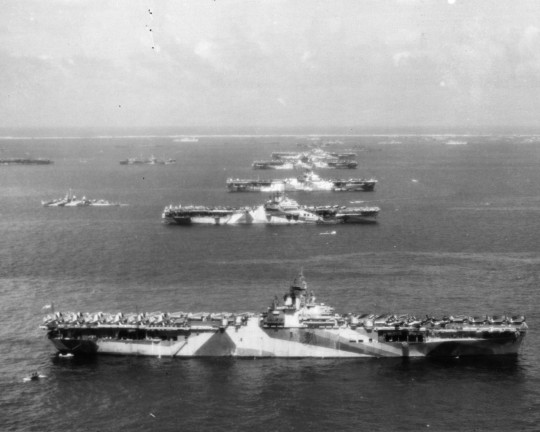
MURDERERS' ROW
Third Fleet aircraft carriers at anchor in Ulithi Atoll, 8 December 1944, during a break from operations in the Philippines area. The carriers are (from front to back): USS Wasp (CV-18), USS Yorktown (CV-10), USS Hornet (CV-12), USS Hancock (CV-19) and USS Ticonderoga (CV-14). Wasp, Yorktown and Ticonderoga are all painted in camouflage Measure 33, Design 10a.
Photographed from a USS Ticonderoga plane. Official U.S. Navy Photograph, now in the collections of the National Archives.
Catalog #: 80-G-294131
28 notes
·
View notes
Text

USS Wasp (CV-18) converted into a troop transport for Operation Magic Carpet – Bayonne Naval Shipyard – New York – November 16, 1945 Essex Class Carrier ....
0 notes
Text

MURDERERS' ROW
Third Fleet aircraft carriers at anchor in Ulithi Atoll, 8 December 1944, during a break from operations in the Philippines area. The carriers are (from front to back): USS Wasp (CV-18), USS Yorktown (CV-10), USS Hornet (CV-12), USS Hancock (CV-19) and USS Ticonderoga (CV-14). Wasp, Yorktown and Ticonderoga are all painted in camouflage Measure 33, Design 10a.
Photographed from a USS Ticonderoga plane. Official U.S. Navy Photograph, now in the collections of the National Archives.
Catalog #: 80-G-294131
1 note
·
View note
Text

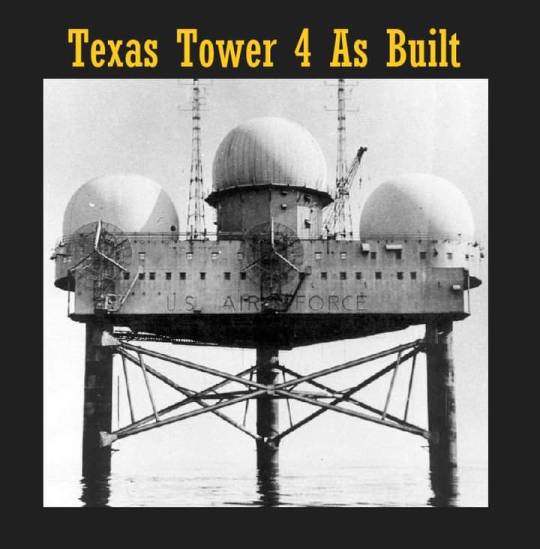
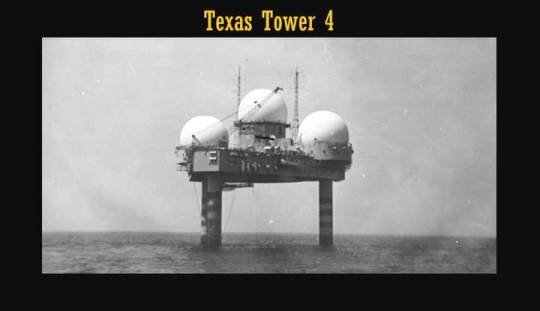


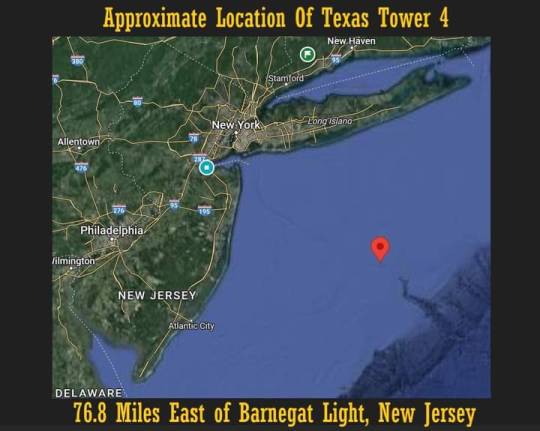
“Tragedy At Sea - The Loss Of Texas Tower 4”
Good evening, everyone. Today is a terrible anniversary, both in the history of our military, and the Jersey Shore.
63 Years Ago, Today - (Sunday) January 15th, 1961, 76.8 miles east of Barnegat Light, NJ:
In the 1950’s, with the Cold War well underway, the military wanted to extend our visibility deep into the Atlantic ocean. To accomplish this, large radar platforms would be built far offshore. With an additional 300 mile increase in range, the towers’ would give the United States additional response time in the event of a nuclear attack by Russian aircraft.
Five towers were planned, from New England to New Jersey. Towers 1 and 5 were never built; Tower 2 was placed on George’s Shoal northeast of Cape Cod, Tower 3 was built on Nantucket Shoal east of Montauk Point, LI, and Tower 4 was built on an unnamed shoal 76.8 miles nearly due east of the Barnegat Lighthouse, in New Jersey. The large platforms earned the nickname “Texas Towers,” due to their similarity with oil drilling rigs in the Gulf of Mexico.
Texas Tower 4 was assigned to the Highlands Air Force Station, here in Monmouth County (present day Hartshorne Woods County Park), with the call signs “Jitney” and “Dora,” as part of the 646th Radar Squadron.
Regrettably, it had a terrible reputation from the start, beginning in 1957. Built on land, it was transported to its shoal via barge. Enroute, two of the three legs were damaged, and the decision was made to repair them at sea - this was never properly done.
The whirring of the massive radar dishes, and their diesel generators, caused extreme reverberation through the entire platform. Due to the depth - 185 feet of water - the Tower’s hollow legs reverberated with the flow of the sea. Not only did the Tower shudder with the waves, it rocked violently, earning it the unenviable nickname of “Old Shaky.”
Repeated pleas for substantial repairs were deferred, and only small piece-meal work was done over time. Requests to abandon the Tower were declined, because of Russian patrol vessels who were ready to swoop in and strip the Tower of its secret materials.
The Tower endured one massive storm after another. It took Hurricane Daisy in August, 1958, and then was battered by Hurricane Donna in September, 1960..
Refusing to the abandon the Tower, the Air Force removed non-essential troops and left a skeleton crew of 14 Air Force personnel and 14 civilian contractors aboard. With the powers-that-be finally acknowledging that the Tower was in danger of collapse, their flash of brilliance to temporarily stabilize it was to mix concrete and dump it straight down the hollow shafts of each legs. As winter of 1960-61 approached, the helipad on the tower filled up with pallets of cement bags. As late as January 7th, Navy Divers, assessing the legs, found the supporting structures were damaged and letting go
As these stories always do, tragedy awaited. A storm arrived in full force - the forecast on January 14th called for winds as high as 60 mph. On the morning of the 15th, the Tower groaned and twisted in ways no one had seen before - another support brace had gone. All day the men on Texas Tower 4 called in damage reports and pleas for rescue.
The Air Force finally relented - but it was too late. At 4 pm, at the height of the storm, they authorized an evacuation, but the weather was too rough for helicopters. All US Coast Guard and Navy ships in the area - including an aircraft carrier, the USS Wasp (CV-18) - made for the Tower at full speed.
At 6:45 pm came the bone-chilling radio message “WE ARE BREAKING UP.”
Texas Tower 4 presented a massive blip on surface radars. Around 7:30 pm, with some ships just miles away - it vanished.
One of the damaged legs finally buckled, and the entire structure crashed into the sea. Texas Tower 4 was gone. And with it, all 28 men. Only two bodies were recovered; the rest were claimed by the sea.
We pause to honor and remember the lives that were lost 63 years ago today off the Jersey Shore. It must be remembered that our Cold War veterans served - and sacrificed - without a shot ever being fired in anger.
28 US Air Force Personnel and Civilian Contractors Lost their lives that day. Of note, many of the civilian contractors were veterans themselves, of several branches. Out of respect so as to prevent confusion, they are listed here without rank, simply by name and age.
They Are:
Abbott, David - 48
Bakke, Roald - 35
Brown, Vincent - 43
Bucherri, Samuel - 45
Cudnick, Chester - 47
Evans, Thomas - 54
Foster, Bishop - 35
Giurastante, Domenic - 19
Green, Kenneth - 27
Haroutunian, Aram - 45
Ide, William - 38
Jones, Leland - 22
Kovarick, Wilbur - 36
Kruse, William - 27
Laino, Louis - 21
Leo, Milton - 50
Martel, Raymond - 34
Opalka, Anthony - 46
Parker, David - 22
Phelan, Gordon - 33
Robertson, Edward - 39
Schutz, Henry - 57
Shaffer, Harry - 37
Smythe, William - 61
Waitt, Donald - 39
Williams, Troy - 39
Wolford, Larry - 24
Yavorosky, Vincent - 44
You Are Not Forgotten
🇺🇸 🇺🇸 🇺🇸 🇺🇸 🇺🇸
🇺🇲🇺🇲 ** Please Like & Follow "Sandy Hook History" on Facebook & Instagram for more amazing maritime and military histories of the Garden State and New York Harbor as well as a day by day review of the 80th Anniversary of the Battle Of The Atlantic and World War 2** 🇺🇲🇺🇲
#visitmonmouth #newjerseybuzz #thejournalnj #locallivingnj #journeythroughjersey #centraljerseyexists #discovernj #yesnj #newjerseyhistory #newjerseyforyou #sandyhookbeach #sandyhooknj #sandyhookhistory #forthancockhistory #forthancock #texastower4 #texastower #coldwar #coldwarveteran #lostatsea #thepricewepay #coldwarriors #thisreallyhappened #newjerseyhistory #njshipwreck #honorourveterans #honorourfallen #youarenotforgotten #missinginaction #unitedstatesairforce
@followers
#sandyhookhistory#centraljerseyexists#discovernj#journeythroughjersey#locallivingnj#newjerseybuzz#newjerseyhistory#sandyhookbeach#sandyhooknj#forthancock#coldwar#coldwarveterans#lostatsea#thisreallyhappened#neverforgotten#honorourfallen#usairforce#unitedstatesairforce#airforce#texastower#texastower4#barnegat#barnegatlight#barnegatnj#barnegatnewjersey#longbeachisland
1 note
·
View note
Text

A McDonnell F2H-2 Banshee of Fighter Squadron 62 (VF-62) "Gladiators" from the aircraft carrier USS Coral Sea (CVB-43) after having mistakenly landed on the aircraft carrier USS Wasp (CV-18) in 1952.
#aircraft#airplane#aviation#military#aviacion#world war ii#wwii#navy#helicopter#army#air force#air defence#aerospace#aviation art
130 notes
·
View notes
Text
Ronnie Bell Following
Curtiss SB2C-3 Helldiver
Curtiss SB2C-3 Helldiver 81 1st bomber squadron (VB-81 Hell Razors in flight over the deck of the American aircraft carrier WaSP (USS Wasp CV-18).
Via Flickr
11 notes
·
View notes
Photo

Crewmen aboard USS Wasp (CV-18) prepare to load a Mark XIII aerial torpedo onto a TBM of VT-14 during operations off Formosa, 13 October 1944. At right is an F6F of VF-14
78 notes
·
View notes
Text

"Gemini-7 (left) and Gemini-6 Aspacecraft meet up once again, this time at Mayport Naval Station near Jacksonville (Fla.) after unloading from the carrier USS WASP. The two spacecraft accomplished a rendezvous and station keeping exercise in space on December 15."
Date: December 20, 1965
NASA ID: S65-65948
#GT-7#GT-VII#Gemini 7#Gemini VII#SC7#GT-6#GT-VI#Gemini 6#Gemini VI#Gemini VI-A#Gemini 6A#GT-6A#GT-IV-A#SC6#NASA#Gemini Program#Project Gemini#Gemini#Recovery#Atlantic Ocean#USS WASP (CV-18)#USS WASP#Essex Class#Aircraft Carrier#Ship#Mayport Naval Station#Jacksonville#Florida#December#1965
70 notes
·
View notes
Text
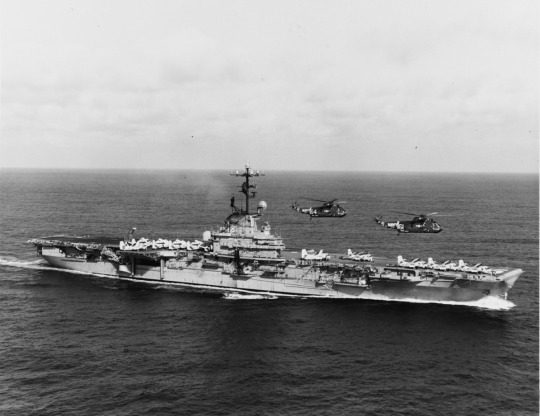
USS WASP (CVS-18) at sea in the Atlantic, with two SH-3 Sea King helicopters flying by in the foreground.
Photographed by Ph2 Stabe.
Date: May 9, 1969
U.S. Naval History and Heritage Command: NH 97510
#USS Wasp (CV-18)#USS Wasp#Essex Class#aircraft carrier#May#1969#United States Navy#U.S. Navy#US Navy#USN#Navy#Vietnam War#my post
83 notes
·
View notes
Text

The aircraft carrier USS Wasp (CV-18) returns to her berth in New York. The forward section of her flight deck was damaged during a typhoon off the coast of Japan on August 26, 1945.
24 notes
·
View notes
Photo

December 17, 1965 Gemini VI re-entry and a Santa Claus sighting ! Just before the Gemini VI spacecraft started its re-entry, astronaut Walter Schirra played “Jingle Bells” on a small Hohner harmonica while astroanu Stafford reported an apparent Santa Claus sighting... the crew was recovered North East of Turks & Caicos by the USS Wasp CV-18 aircraft carrier. Photo shows the crew upon return at Elling Air Force Base near Houston and we clearly see Stafford’s NASA-issued Omega Speedmaster chronograph on a steel mesh Jacoby Bender Champion bracelet. (Photo: NASA)
#321#Omega#Speedmaster#chronograph#astronaut#aviator#bracelet#JB Champion#espace#Gemini#Ellington#Houston#horology#horlogerie#Horloges#jetpilot#military#montres#NASA#USAF#Navy#Omega History#pilot watch#Moonwatch#MoonwatchUniverse#spaceflight#spacefarer#space watches#test pilot#time piece
14 notes
·
View notes
Photo

“USS McCook (DD-496) alongside USS Wasp (CV-18), date unknown (photo filed 21 November 1944). US Navy BuAer photo 180183.”
(Source)
#Military#History#USS McCook#USS Wasp#Destroyer#Aircraft carrier#United States Navy#US Navy#WWII#WW2#Pacific War#World War II
146 notes
·
View notes
Photo
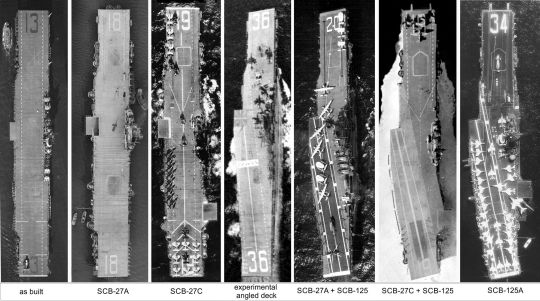
Seven aerial photographs showing the major different modernizations of the U.S. Navy Essex-class aircaft carriers (l-r): USS Franklin (CV-13), a "short hull" type as delivered, 21 February 1944. Franklin, USS Bunker Hill (CV-17), USS Boxer (CV-21), USS Princeton (CV-37), USS Tarawa (CV-40), USS Valley Forge (CV-45) and USS Philippine Sea (CV-47) received no or little modernization. USS Wasp (CV-18), after her SCB-27A conversion in late 1951: new hydraulic catapults, new island, removal of the deck guns, new bow. Modernized as such were USS Essex (CV-9), USS Yorktown (CV-10), USS Hornet (CV-12), USS Randolph (CV-15), Wasp, USS Bennington (CV-20), USS Kearsarge (CV-33) and USS Lake Champlain (CV-39). USS Oriskany (CV-34) was completed as such. USS Hancock (CV-19) after her SCB-27C modernization, circa 1955: like SCB-27A but new steam catapults and relocation of the aft elevator to the deck edge. USS Intrepid (CV-11) and USS Ticonderoga (CV-14) also received SCB-27C. USS Antietam (CV-36) after the installation of an experimental angled deck, circa 1954. USS Bennington (CV-20) after SCB-125: enclosed hurricane bow, angled deck, starboard deckedge elevator. USS Essex (CV-9), USS Yorktown (CV-10), USS Hornet (CV-12), USS Randolph (CV-15), Wasp, USS Bennington (CV-20) and USS Kearsarge (CV-33) received SCB-125. USS Hancock (CV-19) after SCB-125 in April 1957. The three SCB-27C ships were modernized as such an had the starboard deckedge elevator located further aft. The forward elevator was enlarged. USS Oriskany (CV-34) received SCB-125A, here on 30 May 1974. Similar to SCB-27C/SCB-125, only the starboard deckedge elevator was located further forward, as with the SCB-27A/SCB-125 ships. USS Lexington (CV-16), USS Bon Homme Richard (CV-31) and USS Shangri-La (CV-38) received SCB-27C/SCB-125 in one refit but had the starboard elevator in the same position as Oriskany.
2 notes
·
View notes
